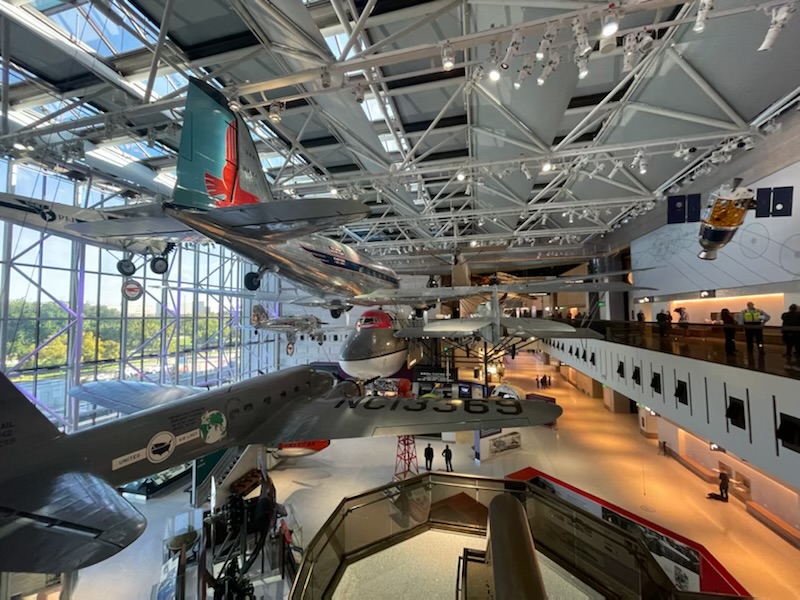For the past six months, the expansive halls of one of the world’s most popular museums have been vacant, save for construction crews and the massive planes hanging from its ceiling. On Friday, Oct. 14, bustling crowds once again filled the halls as the National Air and Space Museum reopened to the public for the first time since construction began in March of 2022.
Eight newly renovated galleries in the West Wing are now accessible to the public, although construction is still ongoing in the East Wing. The massive, $1 billion, seven-year renovation began in 2018 and is expected to be fully completed by 2025 with the opening of all 23 exhibits.
Christopher Browne, the John and Adrienne Mars director, reiterated the museum’s purpose and mission at an Oct. 6 press review. “We’re really in the business of telling stories, telling people’s stories, and how they connect to the artifacts and the technologies we celebrate. And like every story, every good story has a beginning,” he said.
The iconic museum has suffered a high degree of wear and tear from welcoming over 350 million visitors since its opening in 1967, making new renovations a pressing matter. Moreover, Browne stressed that workforce diversification within the aerospace industry as well as changing public attitudes have forced the museum to redirect its focus.
“The aviation and aerospace world has changed incredibly, and who’s participating in it has changed, has become a much more diverse and inclusive space that we want to celebrate,” Browne said. “So we are taking this opportunity to reimagine what I describe as ‘America’s favorite museum.’”
The new exhibits include a variety of artifacts that convey a more representative and inclusive picture of the industry. The museum is debuting the WR-3 air racer—a two-seat, open-top propeller plane designed and built by Neal Vernon Loving in 1967. Loving became the first Black double-amputee in America to become race certified in 1950, and later went on to earn a degree in aeronautical engineering at the age of 40.
The museum will also showcase the Northrop T-38 Talon, a twin-engine supersonic trainer aircraft which Jackie Cochran flew in to set eight speed and altitude records. Cochran, an ambitious racing pilot as well as founder of her own cosmetics company, became the first woman to fly at supersonic speed in 1953.
“That’s a connection point perhaps for a young girl coming into this museum for the first time,” Browne said about the introduction of the Cochran aircraft. “Because if seeing is believing, we want our visitors, particularly our younger visitors, to see themselves in the stories, the possibilities.”
The museum unveiled nearly 100 interactive and digital experiences to engage visitors. Highlights include a digital view of Earth from the International Space Station (ISS) complete with sound effects in the “One World Connected” exhibit. The new exhibit “Nation of Speed ” debuts an Evel Knievel pinball machine that allows visitors to experiment with angles and launch speed in order to jump a pinball from one ramp to another.

Photo by Jupiter Huang The Mariner 10 spacecraft hangs above the Exoplanets exhibit.Photo by Jupiter Huang
Jeremy R. Kinney, the associate director for Research and Curatorial Affairs at the National Air and Space Museum, shared what the exhibits’ curation process looked like in an interview with the Voice.
With its renovation, the museum has been able to acquire and display a variety of new artifacts, many of which arrive at the museum in surprising ways. Kinney highlighted the addition of the original Spock ears from Star Trek as a fascinating example.
“Our artifacts come to us in so many different ways,” Kinney said. “The son of Leonard Nimoy, Adam Nimoy, just contacted the museum, said, ‘Hey, would you like to have these?’ And so we have people coming and reaching out to us.”
According to Kinney, the renovation process was originally meant to overhaul just the museum’s exterior, but was revised to include the entire building, allowing the museum to revisit its exhibits.
The revamping of the museum’s visitor experience continues with the addition of what Kinney describes as an “innovations gallery” that will host rotating exhibitions in addition to the museum’s permanent exhibits.
“It could be six months, two years, five years, a series of rotating galleries to reflect more contemporary trends. The opening exhibition for that is going to be aerospace and climate change,” Kinney said.
Kinney also highlighted the museum’s new educational plans. The museum currently offers online programs and resources to provide learning opportunities, but is adding new family rooms and classrooms to improve the visitor experience.
“Our education program is going to ramp up even more heavily in regards to outreach for both the local community and if any school groups come in and visit,” Kinney said, “That’ll be a prologue to the big education center that [we’re] building with the Jeff Bezos donation.”
Although the museum is emphasizing visitor education as a foundational aspect moving forward, educational spaces are still several years from completion. The classrooms, located in the basement next to the new Mars Café, will offer classes for different age categories in robotics and other science-related fields. They are, however, still in the early stages of construction, and construction on the Bezos learning center hasn’t begun.
To visit the exhibits, innovations gallery, or utilize the free learning opportunities, visitors must reserve a free timed-entry pass—tickets that visitors must reserve prior to visiting the museum.
Ultimately, Browne emphasizes that the museum’s principle goal is accessible learning. “That measure of success that I really hope to achieve is that learners, whatever their age—particularly young learners, however they come to us—can connect at a personal level and get that moment of awe and inspiration that we know can lead to amazing things.”





